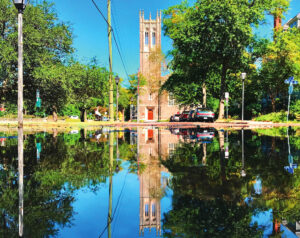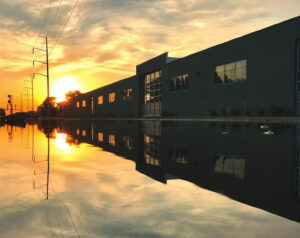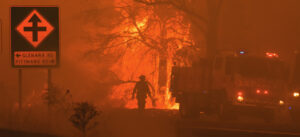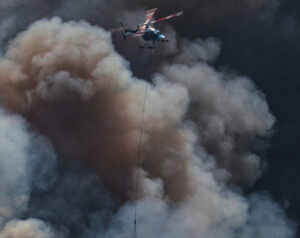
Adapting building standards to changing weather risks
![]()
 The city of Norfolk, Va., is plagued with challenges due to sea-level rise, which results in so-called “sunny day flooding” — that is, encroachment of coastal waters unrelated to storm surge or rain. Norfolk, like many coastal cities throughout the United States and around the world, realizes that this problem will only intensify with time. Drastic measures are required to ensure the resiliency of the city for decades to come.
The city of Norfolk, Va., is plagued with challenges due to sea-level rise, which results in so-called “sunny day flooding” — that is, encroachment of coastal waters unrelated to storm surge or rain. Norfolk, like many coastal cities throughout the United States and around the world, realizes that this problem will only intensify with time. Drastic measures are required to ensure the resiliency of the city for decades to come.
Norfolk participated in the 100 Resilient Cities (100RC) program1. As a result, the coastal city developed a robust plan for community resilience, called Vision 2100,2 which maps the city using anticipated natural hazard planning based on forecasts for the year 2100. Norfolk’s Vision 2100 plan recommends several large-scale actions, including:
- focusing major infrastructure investments, such as schools, water treatment facilities, recreation centers, and libraries, in the areas of the city at the lowest risk of long-term flooding;
- improving transportation, including road transportation for cars and public transportation, bicycles, and pedestrians, to these most resilient areas and all other areas of the city;
- encouraging individual responsibility by residents, businesses, and organizations to implement resiliency strategies, even if their own property is not directly threatened by flooding due to sea-level rise;
- adjusting zoning and incentive programs to encourage the development of housing in areas at the lowest risk of flooding, especially those that create mixed-income neighborhoods to eliminate the greatest risk from being posed to those who are already economically disadvantaged; and
- fostering emergent resiliency-based industries that can develop new technologies and industries.
In a more extreme response to the increasing severity of flooding due to stronger weather patterns, the small Australian town of Grantham, in New South Wales, relocated to a more-resilient location after it was devastated by floods in 2011. The local government provided homeowners with an equivalent-sized land parcel located on higher ground to use for rebuilding to reduce or eliminate the risk to the buildings from future flooding. The government fast-tracked the relocation plan so that residents were able to relocate within the space of a calendar year. Over 115 homeowners (approximately seventy percent of the town) — predominantly those whose homes suffered the most damage — accepted the offer to move. The plan was widely applauded for saving both lives and tens of thousands of dollars in repairs when another flood hit the original town two years later.

The Norfolk and Grantham examples illustrate two among hundreds of communities working to implement resilience initiatives. An increasing number of communities around the globe are experiencing extreme weather events with increased frequency, duration, and intensity. In many cases, these communities have adopted building codes to provide protection from the majority of anticipated hazards. However, as hazards change, building codes and standards developers need to adapt to provide requirements that address potential risks across the lifetime of the structures. In many cases, this is unchartered territory — standards and the designers and regulators that rely on them are rooted in an environment of certainty. Due to this complexity, an international dialogue is underway among organizations that research and develop standards related to construction and building safety.
The codes currently used in Australia, New Zealand, Canada, and the United States all rely on historical data to assess the risk of weather-related hazards to buildings. Therefore, the organizations developing the codes have undertaken a collaborative effort to explore how to improve building codes in order to incorporate more climate science. They initiated the Global Resiliency Dialogue.
The participants in the Global Resiliency Dialogue recognize that the building codes adopted in most countries, which are based on historical climate and weather data, are not able to provide the same level of safety and resilience as in past years and decades. Codes and standards are fundamental to assuring that buildings support the health, safety, and welfare of communities, including protecting life during hazardous events. Therefore, it is crucial that codes and standards incorporate the latest research and data from both building science and climate science to maintain the expected levels of safety and resilience.
The ultimate goal of the participants in the Global Resiliency Dialogue is to create a set of international guidelines that can be used globally to advance further integration of climate science and resiliency measures into building codes and standards. Global Resiliency Dialogue representatives from the four countries, in recognition that resilience relies on the deployment of a comprehensive strategy that engages the public and private sectors, convened a two-day workshop in October 2019. Building code development and research organizations attended the workshop, along with standards developers, fire and disaster management organizations, climate scientists, and architects and engineers from the participating countries. The high-level goal of the workshop was to establish a shared understanding of how adapting the built environment to increasing climate-related risks intersects with the mitigation activities that can be taken to address those risks.
The outcome of the workshop was a joint statement of findings and a commitment to collaborate on a joint initiative to inform the development of building codes that draw on both building science and climate science to improve the resilience of buildings and communities. The workshop facilitated an understanding among the participants of the regulatory building and scientific systems employed in other participating countries as they relate to natural hazard challenges posed by climate change. Through this lens, participants explored a broad range of issues, including extreme wind, rain, flooding, sea-level rise, tidal surge, wildfires, and heat stress, as they create differing approaches to the regulation of buildings and building safety. Organizations identified specific areas in which government and nongovernment entities from the participating countries can collaborate bilaterally or multilaterally to harmonize efforts, produce joint research, or utilize information already existing in one country to apply within the other(s).
Following the workshop, the lead organizations from the four countries, which include the Australian Building Codes Board, the National Research Council of Canada, the New Zealand Ministry of Business, Innovation, and Employment, and the International Code Council (ICC; based in the United States), began to formalize the Dialogue and its deliverables. The first work item, which is nearly complete, is a survey to understand — in detail — how climate-based risks are currently treated in building codes and standards. This includes an exploration of the types of codes (building, energy, electrical, plumbing, etc.) that rely on climate-related data to support their requirements, as well as the source of that climate data, how it is communicated, and how often it is updated. The survey also explores the relationship between expected building life and climate projections, property protection versus life safety, land use/planning/zoning in relation to future-looking hazard assessments, and existing research related to building codes and climate-related risk.
The initial findings indicate a large degree of consistency among the four countries related to the type of climate data that is used in building codes and standards — that is, largely historical — coupled with a general desire or instruction from a governmental authority to employ more forward-looking data, at least in some specific areas. In Canada, for instance, the Climate Resilient Buildings and Core Public Infrastructure Initiative, a public-private partnership, has been working with partners to develop future climactic design data and climate change provisions for consideration for adoption in the 2025 edition of the codes. This effort involves generating a series of climate model results for different design data elements currently referenced in the code for different degrees of global warming. New Zealand is developing a program under its National Adaptation Plan that will provide for future climate change in relevant building code clauses, most likely through the use of modeled climate data. The Natural Hazards Mitigation Framework in Australia includes the direction to work collaboratively with global counterparts and national agencies to research and identify future climate risks and adaptation solutions to enhance community resilience. Additionally, in Australia, a proposed change to the wind code would include a five-percent climate change multiplier to regional wind speeds in cyclonic wind regions.
In the United States, the ICC is developing a series of white papers on how different codes contribute to resilience, although the data sources in these codes are still historical. There is great interest in developing potential strategies that can be used seamlessly with the current format of the International Codes, such as an overlay document (a standard or guideline) that communities wishing to address future climate risks can adopt alongside their code, or a stand-alone standard that would address the process states and localities can use to improve resilience. The American Society of Civil Engineers (ASCE) has also conducted significant research into how its design load standard, ASCE 7,3 can incorporate adaptive design and engineering practice to address increasing risks and climate change. Finally, the US Government agencies often adapt their codes to incorporate additional resiliency measures. This is found particularly in the US Department of Defense, which views climate change as a security risk, and under which the US Army Corps of Engineers and the US Naval Facilities Engineering Command have developed and implemented some forward-looking climate modeling.
The findings also demonstrate that the primary focus of building codes in each of the four countries is predominantly life safety, with property protection as an important secondary consideration. Life safety is generally defined as occupant safety, which includes, to varying degrees, fire protection, structural integrity, health (indoor air quality, plumbing/sanitation), accessibility, and protection of adjacent property. Extreme heat is viewed as an increasing threat, but is only tangentially addressed through energy efficiency provisions and is not currently addressed as a specific risk condition in any of the codes. Flooding and wildfire risk are addressed in some US and Australian codes and standards, but not in New Zealand or Canada.
It is also worth noting that when engineering for infrastructure construction, countries are more likely to utilize more extreme values in climatic parameters, since both the level of stress and the anticipated lifespan of bridges and dams, for instance, are expected to be more severe and over a longer period of time than for residences or smaller buildings.

The challenge is not creating building codes and standards that protect against natural hazards, but instead how these codes and standards should be applied based on changing risk patterns in different geographical areas. As an example, many strong standards have already been developed both in the United States (International Wildland-Urban Interface Code) and Australia (Australian Standard AS3959: Construction of buildings in bushfire-prone areas) to protect buildings in wildfire or bushfire-prone areas. However, the number of buildings and geographical areas in which these standards should apply is shifting and growing as the world continues to experience increased temperatures and increased droughts. The devastating wildfires in the Western United States this year and over the past several years are a testament to this, as were the wide-ranging and long-lasting bushfires that ravaged Australia in late 2019 and into 2020. Indeed, the Australian bushfires this year burned more than fifty times the acreage that was consumed during the Black Saturday fires in 2009. The challenge is ensuring that the codes and standards that are used to guide the design and construction of buildings and homes anticipate the risks that will impact those structures in twenty, fifty, or one hundred years.

It is notable to consider that buildings are generally designed with a fifty- to one-hundred-year life cycle envisioned. Most mortgages in the United States have a fifteen- to thirty-year repayment term. Yet, the natural hazard profile to which buildings are designed (based on even the most advanced codes and standards in current use) is based on historical data, rather than future modeling. In the second phase of work currently underway through the Global Resiliency Dialogue, participants are gathering research to explore what is conceptually possible in shifting the underlying data referenced in building codes and standards to forward-looking models rather than historical data (which may not have been updated for a decade or more). In this phase, the questions being explored include:
- benefits (impacts and outcomes) that can be achieved by designing codes and standards to future rather than historical natural disasters;
- data and supporting research needed to enable codes to consider future climate states and future weather events, and whether any of this research ongoing or completed;
- needed advancements in current climate modeling, including addressing the uncertainty in future climate states and models, to allow its integration into building codes and standards;
- ideal methodology to address climate change in codes (including which models or greenhouse gas emission scenarios to use), and whether this is impacted by the assumed or ideal service life of buildings and the materials used to construct them;
- exploration of challenges in predicting future risk of extreme weather events and how this should impact building design;
- engaging stakeholders and building a culture of resilience in a society that provides equal access to resilient buildings; and
- other barriers that exist to integrating forward-looking climate models into building codes and standards.
These questions are being explored well outside of the circle of building code development and research organizations. Each of the participating countries will seek broad stakeholder input from climate scientists, architects, engineers, builders, contractors, building owners, disaster mitigation agencies, government entities at the Federal, state/provincial/territorial, and local level (including building and fire safety professionals), and the insurance industry.
The guidelines to be developed based on the findings of the Phase 2 work will form a realistic recommendation about how to improve the resilience of buildings based on the availability and limitations of future-looking climate modeling. At the same time, it will be important to recognize the barriers that are faced when moving to a new type of modeling and provide tools for overcoming those barriers. The Global Resiliency Dialogue also seeks to address the discussion of adapting versus mitigating in the context of the limitation that exists to fortify buildings against all natural hazards, without specifying overly fortified structures that have little appeal as living or working environments.
The discussion will consider whether the life safety expectations of buildings are anticipated to protect occupants from one hazard or multiple hazards (without requiring significant repair or rebuilding between disasters). Some of this has already been explored in the development of the Canadian standard CSA S478:19.4 However, the role of durability within the context of resiliency will need to be explored further.
Finally, the role of the insurance sector has heretofore been largely missing from discussions about building resiliency. There is some impact from insurance decisions about whether buildings are eligible for flood insurance — and at what cost — based on sea level rises and increasing storm surges, as well as changing flood maps. However, in some cases, governments will step in and provide some protection, as the US Federal Emergency Management Agency has done for existing buildings in flood-prone areas. Similar challenges exist in the wildland-urban interface in wildfire-prone areas, where construction has been expanding despite the high risk of fire impact, because of economic considerations. In many cases, governmental authorities have required insurance companies to provide insurance to those homeowners even if the risk profile is unrealistic for insurance purposes.
The goal is for the guidelines to form a starting point for countries around the world to consider changes to building codes and standards that will lead to more-resilient communities. The global nature of the effort in an area of common interest and overlapping progress aims to facilitate the sharing of research and information and avoid duplication of effort. If the guidelines evolve into national or international standards, the harmonization and common baseline of understanding will certainly facilitate trade and continued scholarly and technical exchange.
The work of the Global Resiliency Dialogue is expected to continue through the end of 2021, when the guidelines are anticipated to be ready for publication. Input and support from all interested stakeholders are welcomed, and all standards development organizations (SDOs) involved in the building design and construction space are encouraged to sign onto the initiative and provide input into the Phase 2 survey and/or the final guidelines. SDOs in other sectors are likewise encouraged to consider global dialogues resulting in pre-standard guidelines that can lead to international adoption and harmonization in emergent areas like climate change and resiliency. More information about the Global Resiliency Dialogue is available at www.globalresiliency.org.
References
- 100 Resilient Cities, https://www.rockefellerfoundation.org/100-resilient-cities/.
- Norfolk, Virginia’s Vision 2020, https://www.norfolk.gov/DocumentCenter/View/27768/Vision-2100—FINAL?bidId=.
- ASCE/SEI 7: Minimum Design Loads and Associated Criteria for Buildings and Other Structures.
- Standards Council of Canada, CSA S478:19. Durability in buildings
This article originally appeared in the November/December 2020 issue of Standards Engineering, The Journal of SES — The Society for Standards Professionals, and is reprinted with permission.








